Abstract
Energy transition is one of the main pillars of the European Union’s climate change strategy suite. The policies set forth by European Union members to support energy transition are transposed into national policies, strategies, and action plans. Energy transition calls for empowering citizens and communities regarding energy-related initiatives. Of particular importance are smart energy systems and their potential for involving individuals and communities in energy transition initiatives. However, not all citizens are willing to invest in renewable energy or smart appliances. Thus, there is a need for implementing smart energy initiatives, which have three main steps, namely, awareness, mindset (readiness for action), and action. Bearing in mind the lack of uniformity in this area across the European Union, this manuscript assesses the levels of awareness, mindset, and action utilizing the results of a comprehensive international survey, the ECHOES project, with respect to demographic and socioeconomic variables, such as age, income level, and education level. The analysis reveals that 58% of respondents from the West European sample demonstrate a high level of awareness, 56% are ready for action, and 63% already demonstrate action. The percentages are similar for the East European sample, with 56% demonstrating a high level of awareness, 55% are ready for action, and 66% already demonstrating action. Overall, women have higher levels of awareness, readiness for action, and action. For both Western and Eastern European countries, education level and income level are important factors for smart energy adoption, with education levels proving to be more significant for East European countries.
1. Introduction
Global warming is considered one of the most serious problems for humankind in the 21st century. Dramatic increase in temperatures, along with the adverse effects of industrialization, cause environmental hazards threaten future generations. The situation is even more severe given that the capacity of the earth to absorb greenhouse gases is almost at its limit []. Climate change has yet wider implications, impacting food security, energy security, population growth, pandemics, and employment. Thus, an energy transition away from fossil fuels is a moral responsibility of humanity, in addition to its practical implications. In this regard, agreements such as the Paris Climate Agreement play a significant role in the international field towards decreasing emissions by 2050. The European Union (EU) also attaches importance to this point, demonstrating their determination through their climate policies [].
Renewable energy is a significant tool in the fight against climate change. In this respect, the associated energy transition and smart energy technologies have received keen interest from both academic and policymaking communities []. It is also important to understand smart energy systems for policymaking regarding energy transition and the key drivers of the ongoing transformation of the global energy system, which include technological innovation, climate change mitigation policies, and geopolitical developments []. Steep increases in population and consumption make energy resources increasingly indispensable []. Consequently, it is important to acknowledge the emergence of energy transition as a critical policy challenge [].
Studies in the literature suggest that smart energy projects provide significant contributions to energy transition, inducing critically important changes such as actual decreases in carbon emission levels. Therefore, implementing these systems is a vital step in the transition process [].
A review of the existing literature on smart energy systems reveals a strong focus on European countries, mainly as a result of the European Union’s ground-breaking stance in smart energy implementation and its involvement of formal social units, collective decision-making units, and individual consumers []. More recently, increased expectations from returns on investing in smart energy technologies have resulted in more investments in smart grid projects []. There are also a growing number of multinational projects, especially among EU-15 countries. The United Kingdom, Germany, France, and Italy are the countries with the highest investments in smart grid projects [,], with the majority of the projects carried out in Western Europe.
The usage of smart networks provides a more efficient process of transition to renewable energy []; however, their successful implementation is widely hampered by social acceptance problems [,,]. Opposition may be on social, economic, or technical grounds. Hence, smart grids, smart home technologies, and smarter energy play a major role in recent technology and policy discussions about energy efficiency and also pertain to key components in the EU’s energy strategy.
The aim of this manuscript is to improve understanding of the individual’s role in the transition to a renewable energy system. This is achieved through a comparison of individuals from the selected group of Eastern and Western European countries concerning their awareness, readiness for action, and actual activities regarding smart energy systems. Differences in these parameters between Eastern and Western Europe may arise from factors including diverse political traditions, energy resources, historical background, and different energy policies and priorities of states.
The dataset utilised was from the international survey conducted during the European Commission-funded H2020 project, ECHOES []. The survey dataset contains responses from 31 countries, namely, Austria, Belgium, Bulgaria, Croatia, Cyprus, Czech Republic, Denmark, Estonia, Finland, France, Germany, Greece, Hungary, Ireland, Italy, Latvia, Lithuania, Luxembourg, Malta, Norway, Poland, Portugal, Romania, Slovakia, Slovenia, Spain, Sweden, Switzerland, the Netherlands, Turkey, and the United Kingdom. In total, across all countries, 18,037 participated in the survey, and approximately 600 interviews in 28 different languages were conducted.
The data from the survey that correspond to demographic dimensions and smart energy systems are utilized. The United Nation’s classification of 30 Eastern and Western European countries [] constitutes the sample of this analysis. This classification includes 30 out of the 31 countries participating in the ECHOES International Survey, since Cyprus is included in the ECHOES International Survey with 251 respondents but is not categorized as an Eastern European State or a Western European State by UN’s grouping. The required statistical analysis was conducted using SPSS software, commonly used by researchers in the field of Social Sciences and Humanities for analysing large data.
Figure 1 illustrates the Western European and Eastern European countries according to the United Nations (UN) classification. In the Western European countries cluster, Turkey is marked as a special case by the UN in the original source, because, despite its location, Turkey is considered a Western European country for electoral purposes []. Accordingly, this manuscript positions Turkey in the Western European group.
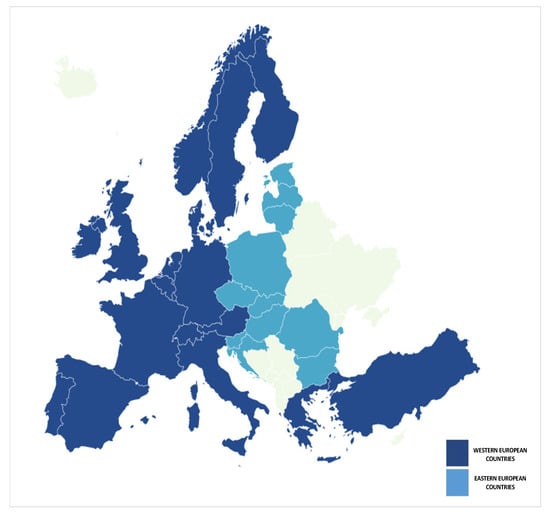
Figure 1.
Map of Country Classification Based on United Nations (Authors’ Illustration).
This division will not only provide a comparison, but also help to understand the underlying differences in terms of individuals’ perceptions and behaviours concerning their awareness, readiness for action, and actual activities pertaining to smart energy systems, and provide guidelines for energy transition policies.
The Eastern European countries are particularly concerned about energy security matters, such as security of supply and diversification of resources. Most of these countries are located on the periphery of Europe and are therefore particularly vulnerable to supply disruptions, especially politically motivated ones, as highlighted by the crisis between Russia and Ukraine in 2009 []. Furthermore, these countries’ technological capabilities and infrastructure are less likely to be sufficient for smart energy transition []. Moreover, smart energy adaptation is made more challenging by limited financial resources, limited renewable energy resources, and a working population dependent on the fossil fuel industry []. Lower standards of living conditions mean that citizens are generally more sensitive to price fluctuations than the rest of Europe [].
Located in the west of continental Europe and along the Mediterranean coast, Western European countries, on the other hand, have a greater commitment to environmental policies and regard renewable energy as a business opportunity. These countries also generally have higher income levels as compared to their Eastern Europe counterparts, and their citizens are less price-sensitive []. One of the common features of Western European countries is their well-developed energy infrastructures and markets. They are also among the leading countries in terms of renewable energy resources and investments, as well as the development of technologies for smart energy systems, including grid automation tools, smart meters, and battery technologies. Most have considerable political-economic power and, therefore, good relations with energy supplier countries [].
This manuscript presents an analysis of the perceptions and behaviours of individuals concerning their awareness, readiness for action, and actual activities pertaining to smart energy systems, using demographic and socioeconomic variables as independent variables. In the context of energy transition, awareness, readiness for action, demonstrating action refers to different concepts. Awareness is framed as a passive attitude, characterized by, for instance, willingness to use energy generated by renewable sources. This state of social acceptance does not always convert to actual behaviour and is impacted by social factors []. This gap between the attitude and the actual behaviour is termed the attitude–behaviour gap or intention–behaviour gap [,,,]. Readiness for action refers to the state where an individual has identified modes of action for adopting behaviour towards energy transition but has not yet turned into actual action. An example would be where an individual has identified alternative utility companies that can provide electricity generated from renewable sources and has information on how to sign a contract with such utility companies, but who has not switched to one yet. Similarly, referring to the ECHOES survey, individuals who state that they, as individuals, can do a lot for energy transition, or people can act together for energy transition, are also perceived as ready for action. Demographic variables include the fundamental demographic characteristics, such as age and gender. Socioeconomic variables, on the other hand, are income level, education, and employment status. The two types of variables are represented by ranges for age groups and income (stated with respect to the median income of the respondent’s country for a normalized set of answers), whereas other attributes are represented by a set of relevant choices: i.e., gender (male/female/other), education level, and employment status (fulltime/parttime/student/unemployed/retired/housewife/husband).
The subsequent analysis is based on the results of the comprehensive ECHOES International Survey, with a high number of participants compared to earlier work in the literature. Another important aspect of the manuscript is that it provides a joint analysis of the perceptions and behaviours of individuals concerning their awareness, readiness for action, and actual activities pertaining to smart energy systems. These dimensions are identified as three critical components for initiatives in smart energy systems, and data on these are valuable inputs for policy formulations. Joint analysis of these three dimensions is not provided in the earlier literature. Moreover, the separate analysis for East European and West European countries can be utilized to formulate better tailored policies that may be effective in different regions. The comparison of the results, including the similarities and differences, also provides further insights.
The results point to similarities and differences between Eastern and Western European subsamples. The demographic variable of gender is revealed as the most important, with women in both subsamples having higher levels of awareness, readiness for action, and action. The next most significant variables for the two subsamples are education level and income level, both socioeconomic factors; however, the order of importance for these two factors is reversed for Eastern and Western Europe.
2. Literature Review
The continuing development of concepts regarding smart energy technologies, including the smart grid concept, means that there is, as yet, no agreement on a single description for a “smart grid”. Among commonly accepted interpretations are “an upgraded electricity network” [] or “the overlaying of unified communications and control system on the existing infrastructure to deliver the correct information to the correct unit” [].
There are two main perspectives on smart energy systems. The first perspective identifies smart energy systems as the intelligent implementations for operating and controlling the components of the energy system. Ingredients of such systems include artificial intelligence and automated algorithms that utilize demand information for optimizing the energy system []. The second perspective defines smart energy systems as the technologies and the accompanying infrastructure that integrate the components of the energy system. This approach specifically emphasizes the emerging need for flexibility in the energy system, imposed by the integration of renewable sources [].
Whether based on artificial intelligence and automation or the integration of smart grids in the energy system, smart energy systems face crosscutting issues, such as interoperability, cybersecurity, standardization, and interoperability. Among the challenges associated with interoperability for smart metering, the significance of the organizational construct for interoperability is mostly cited as a significant challenge. On the other hand, interoperability challenges concerning a scale from smart homes to smart cities are also discussed, identifying standardization, microservice architecture, fog computing, and open source as the proposed solutions to achieve interoperability [,]. An analysis of the components of smart grid architecture highlights interoperability and cybersecurity challenges as outstanding concerns. In this sense, the involvement of a multitude of stakeholders and different architectures for different layers of the smart grid brings about additional complexity issues in terms of interoperability. Concerning cybersecurity, challenges arise from the increased integration and communication between the components of smart grids, making the smart grid more vulnerable to cyberattacks []. A thorough review of the security and privacy standards for smart grids pinpoints cybersecurity and resilience in communication processes as prerequisites for the reliability of smart grids []. Cybersecurity issues with the smart grids, and the increased vulnerability due to massive amount of network activities and data exchange, pose additional challenges for smart grids, including network-based communication systems, embedded processors, control systems, and telecom network insecurities []. Cybersecurity issues in smart grids are also addressed with an emphasis on privacy concerns regarding the protection of consumption data of consumers. To this end, blockchain-based models, e.g., for data aggregation in smart grids, are proposed []. Deep learning and neural networks are utilized as tools to characterize and determine new types of cyberattacks to the smart grids [].
Developing smart energy technologies is seen as a significant priority across the globe, especially in Europe. European countries have long attempted to reduce carbon emissions and achieve sustainability goals, in line with the Paris Climate Agreement [,,,,,]. However, developments are slow, with a limited spread of awareness about smart grids and smart technologies [].
Smart energy technologies, as key components for energy transition, have a crucial role in terms of accelerating the sustainability objectives of Europe. Smart grids and smart energy technologies are vital in reducing carbon emissions and increasing the share of renewable energy and the efficiency of the power sector. In this sense, the behaviours of formal social units, collective decision-making units, and individual consumers play important and different but complementary roles in the energy transition process []. Recent studies in the literature point to strong links between energy transition and a variety of social, economic, and environmental aspects, including poverty reduction, inequality, climate change mitigation, national security, economic growth, and global energy trade. Hence, an effective energy transition should include a gradual shift towards a more modern, comprehensive, sustainable, affordable, and secure energy system that can provide solutions to global energy challenges [].
Consideration of the three levels of decision-making also highlights a range of different but largely interdependent factors in the shift towards an effective energy transition. With regard to formal social units, for instance, government support, energy behaviour, and smart controls are crucial for the energy transition process []. As well as their need for support, formal social units themselves have a critical role in implementing public policies and regulations for the success of smart grids [,]. In this context, the electric vehicle industry is also a significant participant in smart grid transition and is considerably affected by tax regimes and subsidies []. Also crucial in terms of renewable energy implementations is the development of infrastructures []. When considering the failure of smart energy applications, one of the foremost factors is a lack of general and inclusive practices []. Other barriers include social resistance and uncertainty over the profitability of smart grids that, in turn, further stimulates resistance. These issues can lead to short-term financial reservations, acting as barriers to the process [,,].
Regarding smart energy implementations, important variables for collective decision-making units are community acceptance and trust []. Even when these are achieved, concerns about climate change rarely turn into action. The two main difficulties behind this phenomenon are the inability to make connections between perceived problems and possible solutions and the association of environmentally friendly actions with high costs. A related key determinant that affects behaviours and actions regarding smart energy is habitual behaviours, which require policy changes to stimulate people into moving away from carbon-intensive lifestyles []. For collective decision-making units, energy self-sufficiency is an important motivator and should be supported by policies []. Local community energy initiatives and investments are important in achieving the future goals of 100% sustainable energy, energy neutrality, and zero carbon emissions in the journey towards “zero impact” [].
Smart energy technologies are sensitive to consumer engagement and trust. Regarding individuals, citizen, consumer, and social acceptance are identified as essential factors for the success of smart grids [,]. The goal of acceptance of technological innovations by consumers has not yet been reached, and interest remains limited to technology and economic incentives. User acceptance is shaped by certain variables, such as demographics, perceptions, experiences, and contextual factors [,]. Demographic factors such as education, age and job status are strongly correlated with adaptation to smart technologies and awareness of climate change []. Economic factors, such as income, also affect these preferences and consumption patterns []. Another group of factors affecting attitudes are household characteristics and country of residence [,]. Several studies support the hypothesis that willingness to participate in low-carbon energy systems is related to higher socioeconomic background and is inversely related to age [,]. Another important factor is individuals’ personal attitudes to the environment; environmental motivations have been shown to increase willingness to accept smart environmental technologies [,]. However, unfortunately, due to a lack of knowledge and commitment, positive attitudes rarely turn into action [,].
As with many aspects of energy transition, public awareness and social acceptance are crucial for the deployment of smart energy systems. A content analysis was conducted on tweets from Germany and USA in order to analyse public awareness and privacy concerns regarding smart meters in the two countries, utilizing the Natural Language Processing method. Higher awareness and higher tendency towards e-mobility in Germany, as compared to USA, and increasing interest towards smart meters despite privacy concerns were identified []. Society plays a critical role in smart city implementations. In this respect, public awareness and social acceptance stand out as the main drivers for the scalability of such implementations []. A study that investigated the level of awareness of consumers and their acceptance of smart meters in Poland, utilizing the results of an online survey conducted through social media platforms, concluded that, although social media users are not very much interested in tracking their own energy use, energy savings in households may be triggered by real-time information on their consumption. Likewise, a higher awareness of smart meters is expected to lead more people to use smart meters for energy savings. At this point, insufficient information provision through traditional communication channels is identified as a significant factor affecting the awareness of smart meters negatively. The social aspects are also determined to be important, where the discussions and sharing of ideas among members of society, especially those pertaining to positive experiences, are also determined as potential motivators for the deployment of smart meters. Finally, data privacy concerns and the stress resulting from continuous monitoring of increasing energy consumption are among the factors that adversely affect social acceptance of smart meters []. Another study utilized a literature review and a survey in order to identify the performance metrics for smart energy technologies for households. The results identified perception and attitude as the main drivers of the adoption of smart energy technologies. The level of acceptance, in turn, was affected by technical characteristics and features, interoperability, ease of use, trust, and economic benefits as motivators, and by risk perceptions, cost considerations, privacy, and security issues as barriers []. Through an investigation of the social acceptance of domestic demand response among households utilized in case studies, it was concluded that, in order to increase social acceptance levels for demand response, convenience needs to be prioritized over monetary considerations. The results also pointed to the characteristics of the appliances, as well as external factors such as weather conditions, space requirements, and the social environment, as significant factors affecting social acceptance. Factors related to reliability, ease of operation, ease of feedback, and interoperability were also identified as important aspects concerning acceptance []. The effects of the COVID-19 pandemic on smart energy technologies have also been discussed in recent studies. The boost in the use of online technologies, including remote control and operation of systems, coupled with the deployment of smart energy technologies such as smart meters, brings about a new discussion of social acceptance versus enforced conformity to such implementations. In such a setting, in order to achieve the social acceptance of smart energy systems, a more inclusive discussion involving policy makers, society, technology developers, and user groups is needed for adapting these systems and technologies according to user needs and preferences, as well as alleviating concerns regarding data protection and privacy [].
Efforts from policymakers concerning the uptake of smart energy systems involve promoting the development of smart grid capacities, public awareness-raising, and behavioural or perception change strategies. A review of smart grid-related policies of the EU, along with the challenges faced, progress made, and likelihood of success of these policies, marks the Strategic Energy Technologies (SET) as the initial policy tool for supporting the development of support grids, followed by the roadmap and the strategic research agenda for 2035. The initial action plans include initiatives and funding schemes for smart grids established at the EU level as well as national levels. The smart meter deployment program is the first smart grid project at the EU level. Starting in 2001, this project resulted in up to 10% reductions in energy consumptions through the installation of 45 million smart meters in 12 EU countries []. As of 2017, around 950 smart grid projects in the EU are identified. The highest number of projects are observed in Germany, the United Kingdom, Denmark, Spain, France, and Italy, respectively, whereas the highest smart grid investments are in Germany, the United Kingdom, France, Spain, Denmark, and Italy, respectively. There are significant differences between member states in terms of the quantity, size, and general progress of smart grid projects. The factors affecting these differences are identified as policy frameworks, regulatory infrastructure, promotion schemes at the national levels, convenience for foreign investment, availability and adoption of roadmaps for smart grids, availability of national funding, or European co-funding. Overall, most smart grid projects are financed through private investment, with national or European funding motivating and supporting investments. The actors with the highest levels of investment are the distribution system operators. Public institutions, utility companies, transmission system operators, retail companies, industry associations, universities, and other non-traditional stakeholders, such as housing associations, the utility companies of local governments, energy cooperatives, and transportation companies, are observed to increase their smart grid investments [].
A significant result from the literature review is that, despite the pioneering work of policymakers, smart energy transition is impossible without engagement at the level of the individual and society. Hence, it is of utmost significance to understand individuals’ perspectives, opinions, perceptions, and behaviours. The same principle applies to the policy-making processes, where consideration of citizens as individuals, and of their perceptions, awareness, and acceptance, is a prerequisite for formulating well-designed and implementable policies.
It is important to note that the studies in the literature have limited geographical foci and that the current manuscript is the first effort to cover the majority of European countries.
3. Methodology
The analysis in this manuscript is based on a quantitative analysis involving the investigation of the correlation between demographic and socioeconomic variables, selected as independent variables, and three types of variables pertaining to perceptions and behaviours regarding smart energy systems, selected as dependent variables. The independent variables for demographics are “age” and “gender”, and for socioeconomic variables, “income level”, “education”, and “employment”. The three types of dependent variables are classified as “awareness”, “readiness for action”, and “action” regarding smart energy systems.
The correlations for independent and dependent variables are analysed for each country subgroup, Western and Eastern Europe.
Figure 2, below, illustrates the research design of the manuscript.
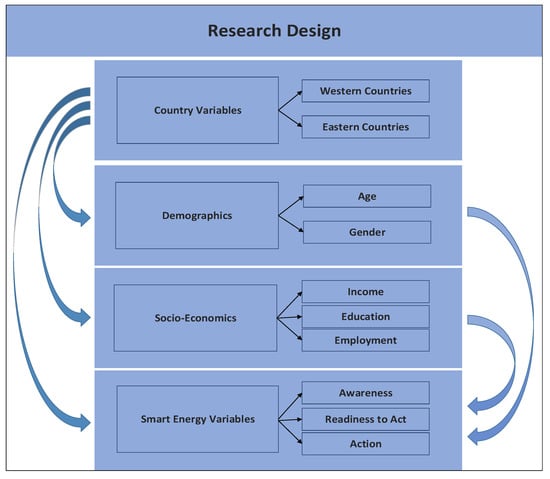
Figure 2.
Research Design.
3.1. Data Selection and Research Design
A survey methodology was widely used in understanding individuals’ opinions, actions, and preferences on a particular subject, as well as their overall attitudes. For instance, the factors that motivate individuals to adopt “smart consumption and production behaviours” were investigated through a survey []. This understanding is important for implementing effective behaviour-change initiatives and potentially contributes to the acceptance of smart grids. Online survey data was also utilized to examine the participation of Dutch citizens in the smart energy transition process []. Survey methodology was also used in the analysis of individuals’ behaviours in energy transition, electric mobility, energy savings, and energy efficiency improvement [,,,,].
This manuscript utilizes a comprehensive international survey to understand individuals’ positions regarding energy choices in the transition to renewable systems. The survey used was conducted as part of the European Commission-funded ECHOES (Energy Choices supporting the Energy Union and the Set-Plan) project. The survey was designed to increase the understanding of factors that influence individuals’ energy-related choices, behaviours, and beliefs, and contains responses from 31 countries, the EU-28 (including the United Kingdom), Norway, Switzerland, and Turkey. The survey was conducted online within a timeline of four months in 2018 through a recruitment process utilizing the random sampling technique. In total, 18,037 respondents took the survey in 1 of 28 languages. The 114-question online survey reached groups of varying age ranges, incomes, and socio-cultural backgrounds, and was balanced in terms of respondents’ gender.
Of the three themes covered in the survey, namely, electric mobility, energy efficiency in buildings, and smart energy technologies, this manuscript focuses solely on the last mentioned.
Representativeness of the data was verified by an analysis of the descriptive statistics for the demographic and socioeconomic variables. This analysis was performed for the whole data, the Western European data, and the Eastern European data. The results show that the data is representative of the associated population, hence the conclusions drawn from further analysis of the sample can be generalized to the associated populations.
The second step of the analysis involved the identification of survey questions concerning smart energy systems and classifying these into three categories: “awareness”, “readiness for action”, and “action”. Out of the 114 questions of the ECHOES International Survey, 22 questions were identified as relevant to smart energy systems. Accordingly, of the 22 questions identified, 9 were associated with “awareness”, 11 with “readiness for action”, and 2 with “action”. Table 1 illustrates these questions and their classification.

Table 1.
Smart Energy-Related Survey Questions and Their Classification.
The relationship between the independent and dependent variables are analysed using the t-Test, with a significance level of α = 0.05.
3.2. Statistical Analysis
3.2.1. Descriptive Statistics and Representativeness of the Data
The demographic and socioeconomic variables, along with their ranges are given in Table 2 below:

Table 2.
Demographic and Socioeconomic Variables and their Ranges.
In survey studies, the representativeness of the sample is essential for reliability and accuracy. To verify the representativeness, the following dimensions were analysed: age, gender, employment, education, and income. In the following section, we present the representativeness analysis for the whole sample and the Eastern and Western European respondent subsamples. The Eastern–Western grouping of respondents is based on the United Nations (UN) classification.
Figure 3 illustrates the distribution among age groups. The analysis of the distribution of age groups reveals that the youngest group was the largest; the highest number of respondents were in the 18–34-year age group (34.8%). The population of the analysed sample was generally younger than Europe’s median age, which is 43.1 years [].
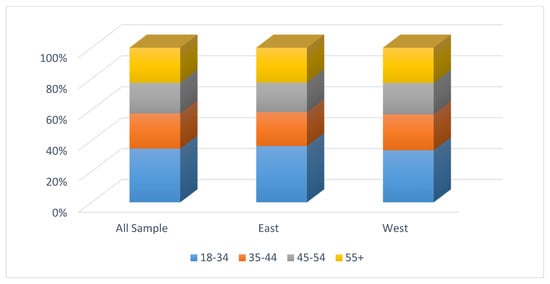
Figure 3.
Distribution of Age Groups.
Of the respondents, 6630 were residents of Eastern European countries. The age distribution of this subsample is as follows: The 18–34 age range has a share of 36.5%, 35–44 has 21.9%, 45–54 has 20.2%, and 55+ has the remaining 22.5%. The age range with the highest number of respondents is 18–34, while the other age groups had approximately equal shares. Therefore, it is expected that the sample will generally reflect the characteristics of this larger younger group.
The Western European subsample has a higher number of (11,156) respondents. The age distribution of this subsample is as follows: The 18–34 age range has a share of 33.7%, 35–44 has 23.3%, 45–54 has 20.2%, and 55+ has the remaining 22.7%. Hence, the Western Europe subsample has similar characteristics to the main sample in terms of age distribution.
Regarding gender, the sample consists of 9099 men, 8930 women, and 8 others. Figure 4 illustrates the frequencies of gender; the distribution of male and female is calculated as 50.4% and 49.5%, respectively.
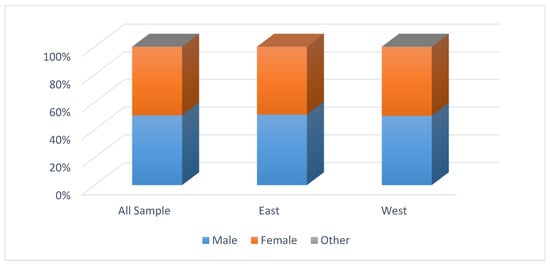
Figure 4.
Distribution of Gender.
Of the Eastern Europe respondents, 51% (3379 respondents) are male, and 49% (3251 respondents) are female; thus, this is representative in terms of gender distribution.
In terms of gender, 50.1% (5592 respondents) are male, 49.8% (5556 respondents) female, and 0.01% (8 respondents) replied as “other”. The Western European subsample is representative in terms of gender distribution.
Figure 5 depicts the frequency distributions of the main sample of the ECHOES International Survey and East and West subsamples regarding employment status. According to the European Commission (EC), as of February 2018, the rate of unemployment in the Euro area was 8.5% []. In the sample, this rate is 6.1%. However, this figure excludes students, people doing housework, those not in paid employment, and retired people.
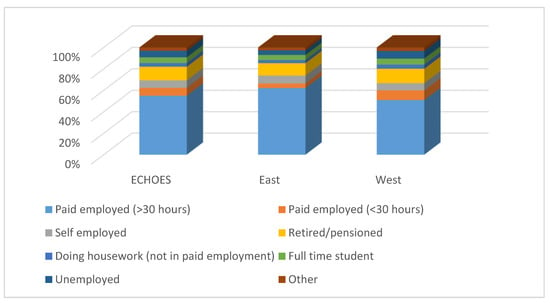
Figure 5.
Distribution of Employment.
In terms of employment, 62.2% of the Eastern European respondents are in paid employment (30 h a week or more), and 11.6% are retired/pensioned. Hence, the Eastern Europe subsample generally matches the whole sample in terms of employment, but with a lower proportion in the “unemployed” category.
51% of the Western European respondents are in paid employment with 30 or more hours a week, and 9.1% with fewer than 30 h. The percentage of retired/pensioned is 13.4%. These results are in line with both the Eastern European subsample and the overall sample.
Regarding the levels of education demonstrated in Figure 6, around 48% of the sample have at least university or college degrees, followed by 21.7% for A-levels (university entrance qualifications); i.e., it seems that the survey was generally completed by the better educated.
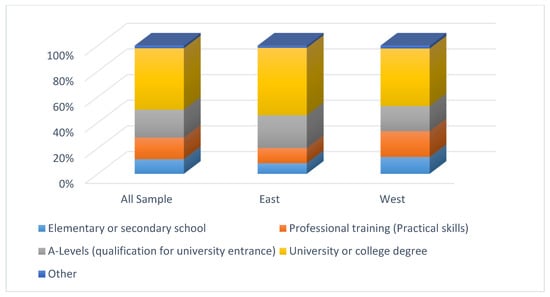
Figure 6.
Distribution of Education.
For the Eastern Europe group, university or college degrees predominate with 56.2%, followed by “A-levels” (university entrance qualifications) with 25.4%, suggesting that the survey was generally completed by the better educated. For the level of education, the highest proportion was “university or college degree” with 45%, followed by professional training (practical skills) with 20.1%, and A-levels (university entrance qualifications) with 19.6%. The education level of the Western European cluster, therefore, is relatively lower than the Eastern European group, which reflects the situation in the general population.
The survey question regarding respondents’ income levels was formulated in comparison with the median income of the country of residence; i.e., the associated responses were normalized. Figure 7, presented below, shows the distribution of income levels: 76.7% of the respondents’ incomes was greater than their country’s median; i.e., the survey generally covers a higher-income sample.
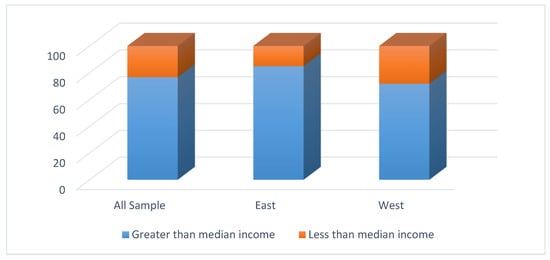
Figure 7.
Distribution of Income.
Regarding income levels, 84.9% of Eastern European respondents stated that their monthly income is higher than the country median, similar to the main sample.
Of the Western European subsample, 71.8% stated that their monthly incomes are higher than the country median, in line with both the overall sample and the Eastern European subsample, although the proportion was lower than both. However, this agrees with the income distribution of the general population.
As a result, the overall sample, as well as both subsamples, can be considered representative.
3.2.2. Hypothesis Testing
In this part of the analysis, individuals’ smart energy choices were compared in terms of demographics and socioeconomic variables using the “Independent Sample t-Test” tool of the SPSS software.
In the comparison process, for each subsample, each question was analysed separately for each demographic and socioeconomic variable, as shown in Table 3 and Table 4. In the tables, ‘+’ denotes a significant relationship as a result of the t-Test, and ‘−’ denotes that a significant relationship has not been identified as a result of the t-Test on the sample.

Table 3.
t-Test Results of Eastern Europe Subsample.

Table 4.
t-Test Results of Western Europe Subsample.
t-Test Results for the Eastern Europe Subsample
Results of the statistical analysis of the Eastern European subsample show that 11 out of 22 questions demonstrate significant differences with age, 20 questions demonstrate statistically differences with gender, 7 questions with employment, 15 questions with education, and 12 with income level.
Considering the effect of age, in 4 of 9 questions in this subcategory, younger groups are more “Aware” regarding smart energy systems as compared to older groups. Similarly, younger groups are better prepared regarding 5 out of 11 “readiness for action” or “mindset” questions and significantly more engaged regarding both questions in the “active” subcategory.
As for the “awareness” questions, younger respondents have a greater appreciation of the benefits of renewables for the environment. Moreover, they have stronger beliefs in the role of society and consider that growing numbers are making efforts to save energy and support energy transition policies. They also have stronger negative feelings towards those resisting the trend towards energy conservation and other more environmentally friendly measures. Regarding readiness for action, younger groups take more pride than other age groups in energy-saving efforts. Regarding their own behaviour, this group feels a greater obligation to be energy efficient and to support energy transition policies. Finally, they have a greater commitment to investing in renewables. In terms of action for smart energy systems, they are better able to adapt to the demands of the energy transition, and more likely to define their actions as pro-environmental.
According to the t-Test results, the gender factor demonstrates a significant difference with the highest number of dimensions, that is, with all but 2 (one corresponding to awareness, the other, to readiness for action) of the 22 questions. That is, women are significantly more “Aware”, “Ready for action”, and “Active”.
Employment status seems to have relatively less impact on perceptions and behaviours concerning smart energy systems. Paid employed individuals demonstrate higher awareness in only 2 of the 9 questions measuring awareness, 5 of 11 measuring mindset or readiness for action, and in neither of the questions measuring activity regarding smart energy systems.
Respondents in paid employment demonstrate a higher level of awareness than other groups in the employment category, identify more strongly with the environment, and are more aware of the growing trend towards saving energy. This group is also more motivated by society to prepare for action regarding smart energy systems. Compared to other groups, paid employees consider themselves more likely to be environmentally friendly if most others are, believe that people would support reduced energy consumption, and believe that people can act together for the energy transition. Hence, they have greater confidence in their influence on energy transition and greater commitment to investing in renewable energy.
Education level stands out as the most influential factor after gender, in the sense that it demonstrates a significant difference with the highest number of dimensions concerning smart energy system perceptions and behaviour. The better educated demonstrate awareness in 6 of the 9 questions relevant to this issue, readiness for action in 7 of 11 questions, and are already taking action, according to both relevant questions.
Respondents with higher education levels are more likely to perceive themselves as citizens of their country, consider themselves to have a stronger relationship with the environment, and are more concerned about temperature rise. Accordingly, they feel more discomfort with those not saving energy and see the use of renewables as an important factor for the environment and employment. In this sense, they show greater support for energy transition policies that create new jobs, even if at extra cost. In terms of mindset, these respondents feel more obliged to be energy efficient and to support energy transition policies due to their greater commitment to investing in renewables. In this sense, they have greater trust in society, are more likely to become more environmentally friendly if most others are, have a stronger belief that people support reduced energy consumption, and thus, will support their own energy-saving efforts. In terms of actions, the better educated are more inclined towards defining themselves as pro-environmental and to state that their energy use is in line with energy transition.
Income level is the third most important socioeconomic factor, with significant results for 12 out of 22 questions. Higher-income levels imply higher awareness in 4 of 9 questions, higher readiness for action in 6 of 11 questions, and more activity in terms of smart energy systems in both questions.
The results point out that the respondents with income levels above the country median are more likely to express stronger relationships with the environment and to believe in the benefits of renewables for the environment. This group of respondents have a greater awareness of rising temperatures and their human causes. Accordingly, they feel more obliged to be energy efficient and take more pride in saving energy. Respondents with higher income levels have greater trust in society, a stronger belief that people would support their own efforts to save energy, and stronger support for energy transition policies. They also are more committed to investing in renewables and have greater faith in collaborative action for the energy transition. In terms of actions, these respondents define their actions as pro-environmental and are more likely to state that their energy usage is in line with energy transition. The ranking between the effects of education and income levels for the East European sample is also justified by multiple linear regressions, where education has more than 50% higher coefficients as compared to income level.
t-Test Results for the Western Europe Subsample
Analysis of the survey data indicates more uniform results from the Western compared to that of the Eastern European subsample, except in the cases of the relationship between smart energy perceptions and behaviour with income level, which highlights a stronger relationship. That is, for the Western sample, there is a smaller set of relationships that can be attributed significant differences through the t-test. In the Western European subsample, 8 out of 22 questions demonstrate significant differences with age, 18 questions with gender, 8 questions with employment, and 14 questions with education, whereas 16 questions demonstrate significant differences with income level.
Regarding the effect of age, younger groups in the Western European subsample are more aware with respect to 5 of 9 relevant questions, more ready for action according to only 2 of 11 relevant questions and have taken more action according to 1 of the 2 associated questions.
Younger age groups have a stronger connection with their country, in terms of perceiving themselves as citizens. Likewise, they profess a stronger relationship with the environment. They believe that rising temperatures are caused by human activity and see renewables as a remedy. This is reflected by the younger group’s stronger belief, compared to the other age groups, in renewables benefit the environment and employment. Their greater trust in policies, as compared to other age groups, is shown by their acceptance of energy transition policies, and their belief that these policies will create jobs, even at some extra cost. In terms of actions, younger groups have a greater tendency to define their actions as pro-environmental.
Only 2 questions regarding awareness and 2 regarding readiness for action lack sufficient information for significant differences with gender. For the remaining 18 questions, women have greater awareness, readiness for action and involvement in activities than men.
For employment status, paid employment induces higher awareness in 2 of 9 questions, higher readiness for action regarding smart energy systems, in 5 of 11 questions, and a higher level of activity, in 1 of 2 relevant questions.
Western European respondents with paid jobs associate themselves more with the environment than other groups in this category and also have a higher awareness of rising temperatures. They demonstrate greater trust in energy transition policies, hold a stronger belief that cooperation can bring energy transition, and are more committed to investing in renewables. Regarding their perceptions about society, they have greater confidence than the other groups in this category that society would support their efforts to use less energy, and their backing for energy transition policies, which they feel obliged to support. They also have a stronger belief in the potential for cooperation in the energy transition. In terms of actions, they define their energy usage as being in line with energy transition.
As with the Eastern subsample, in the Western subsample, education is an important driver regarding perceptions and behaviours pertaining to smart energy systems and is the second most influential socioeconomic factor. Higher educational levels translate into awareness for 5 of the 9 relevant questions, into readiness for action, for 7 of the 11 relevant questions, and into action for both relevant questions.
Better educated groups show higher degrees of awareness regarding rising temperatures, and that this results from human activity. They define themselves as having a strong relationship with the natural environment, and also have greater beliefs in the growing trend toward energy-saving efforts and supporting policies for the energy transition. Regarding their mindsets, higher education groups feel more obliged to be energy efficient and to support energy transition policies, and they believe that energy transition policies create jobs, even if at some extra cost. They are more oriented to how society behaves, more likely to be environmentally friendly if most others are, take pride in saving energy, and likewise, believe that people would support their positive attitude to policies for energy transition. As individuals, better educated respondents are more committed to investment in renewables, and in terms of actions, demonstrate more pro-environmental action and energy use in the energy transition process.
Income level is second only to gender among demographic and socioeconomic factors. Sixteen of twenty-two questions show that higher income levels significantly affect perceptions and behaviour towards smart energy systems. That is, significant results were found between income levels and 6 of 9 questions for awareness, 8 of 11 questions for readiness for action, and both questions for action.
Higher-income groups among Western European respondents have stronger awareness regarding the natural environment, rising temperatures, and human activity-related causes. They perceive renewables as beneficial for the environment. They also have stronger confidence in the efforts of growing numbers to save energy and support policies for energy transition. Higher-income also has strong relationships with the feeling of obligation to be energy efficient and support for energy transition policies, and the high-income group is more environment friendly if most others are. As for the individual perspective, higher-income respondents believe in their ability to influence the energy transition process. They also have a positive attitude to investing in renewable energy. Regarding their social environments, the higher income respondents take pride in people saving energy, and in turn, believe that people would support them if they favoured energy transition policies and that cooperation is possible for the energy transition. The ranking between the effects of education and income levels for the West European sample is also justified by multiple linear regressions, where income level has slightly higher coefficients as compared to education.
Comparison of Results for the Eastern and Western Europe Subsamples
Results of the t-Tests have shown different levels of significance concerning the categories of awareness, readiness for action, and action for the Eastern and Western Europe subsamples. Figure 8, Figure 9, Figure 10, Figure 11 and Figure 12 demonstrate a comparison of the Eastern and Western Europe subsamples in terms of the percentage of questions in each category that suggest significant relationships with age, gender, employment, education, and income, respectively.
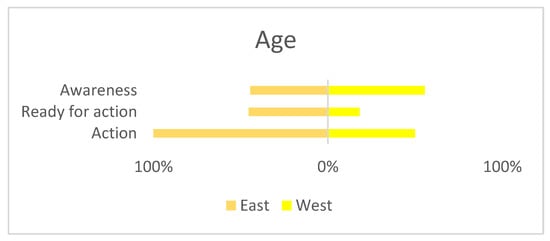
Figure 8.
Comparison of East and West European Subsamples with respect to Age.
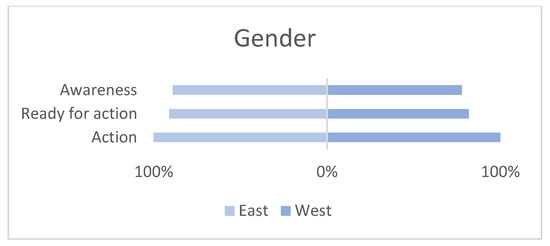
Figure 9.
Comparison of East and West European Subsamples with respect to Gender.
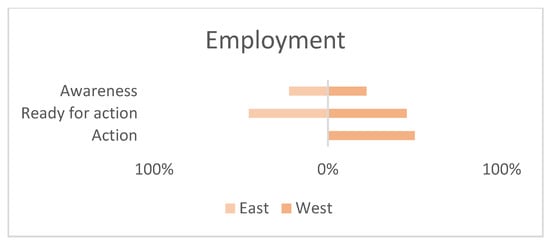
Figure 10.
Comparison of East and West European Subsamples with respect to Employment.
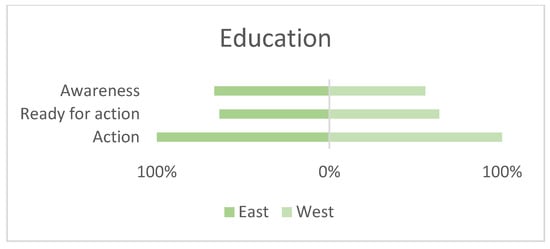
Figure 11.
Comparison of East and West European Subsamples with respect to Education.
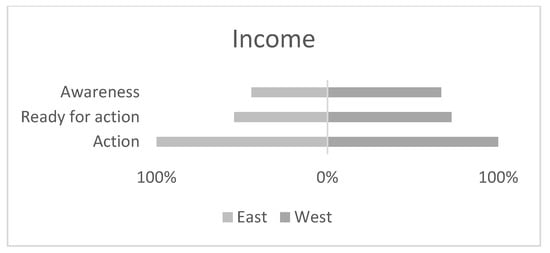
Figure 12.
Comparison of East and West European Subsamples with respect to Income.
In terms of awareness, the West European subsample demonstrates a slightly higher level of association with age, whereas, concerning readiness for action and action, the East European subsample demonstrates higher levels of association in terms of number of questions that suggest significant relationship.
In both West European and East European samples, gender is observed to demonstrate significant relationship with a high percentage of questions in all three categories, with a slightly higher percentage for the East European subsample.
In terms of awareness and readiness for action, employment demonstrates a significant relationship with around 20% of the questions, both for the East European and West European subsamples. When readiness for action is considered, both subsamples demonstrate an association with around 45% of the relevant questions. The two subsamples reflect decidedly different results concerning action. For the West European subsample, all questions regarding action point to a significant relationship with action, whereas in the East European subsample, none of the questions concerning action have a significant relationship with employment.
Education is associated with a high percentage of questions concerning awareness, readiness for action, and action both for the West European and East European samples. The association of education with awareness is slightly higher for the East European subsample as compared to the West European subsample. For both subsamples, education displays a significant relationship with all the questions concerning action.
The West European subsample demonstrates a stronger association with income level, where the association is reflected by a significant relationship with 67% of the questions concerning awareness, 72% of the questions concerning readiness for action, and 100% of the questions related to action. For the East European subsample, the association of income with awareness and readiness for action is lower, whereas 100% of the questions related to action demonstrate a significant relationship with income level, as with the West European subsample.
4. Conclusions
Renewable energy is an effective tool for countering climate change, and the survey shows considerable interest in the transition to renewables and smart energy technologies. Understanding citizens’ perceptions and behaviours regarding smart energy systems as features of energy transition is crucial, not only for designing implementable and successful policies but also for assessing and planning for the individual’s role in the transition. Evidence from the literature highlights citizen awareness, acceptance, and involvement as three critical components for initiatives in smart energy systems, and data on these should inform policy formulations.
This manuscript utilizes data from an extensive international survey to provide insight into how individuals perceive and behave toward smart energy systems and also reveals the effects of key demographic and socioeconomic variables in the Eastern and Western European subsamples.
One significant result from this analysis is the importance of the gender dimension in terms of all three dimensions: awareness, readiness for action, and action. This dynamic, coupled with the fact that women have the primary influence on household decisions, can be utilized to foster the deployment of smart energy technologies in homes. Energy transition policies that target women in terms of increasing awareness, attitude change, and participation in smart energy initiatives or the use of smart energy technologies can be tailored to motivate the deployment of smart energy systems.
For Eastern European countries, other significant socioeconomic factors include education level and income level, respectively. This result has several implications. To begin with, more positive attitudes and behaviours towards smart energy systems are expected to emerge in segments of society that have higher education levels. This segmentation may be utilized towards the formulation of awareness increasing and information provision campaigns regarding smart energy systems. Another way of utilizing this result is implementing policies for increasing the level of education and incorporating sustainability, climate, and environment-related topics into education curricula. Since, for the Western European countries, income level turns out to have higher relevance to the adoption of smart energy systems, policies targeting social acceptance can be designed towards lower-income groups, emphasizing the economic benefits of smart energy systems, particularly pointing out the affordability of associated investments. At this point, policies involving incentive schemes, for instance, smart meters and publicity towards these incentives, may also be effective. This result also points to the fact that efforts towards the fair and equal distribution of income is also critical for the deployment of smart energy systems.
As the results do not demonstrate greater interest in younger ages concerning smart energy systems, this points to a significant potential threat and calls for prompt policy action. The younger population’s awareness is crucial due to the potential dynamism and momentum they can provide smart energy initiatives. Hence, there is a need to focus on both short-term action policies and plans for the implementation of awareness increasing campaigns, training programs, initiatives, and incentives.
The results also highlight the potential for a mindset shift in the younger Eastern European population, the potential drivers of future action for smart energy initiatives, and an inevitable component of citizen empowerment for energy transition. However, this segment of society currently seems unprepared to lead without support from policies aimed at increasing their own and their communities’ self-confidence to benefit the environment and the energy transition process. These policies may include planning showcases demonstrating the benefits of community initiatives, providing the resources for individuals and the community to contribute to the energy transition, disseminating examples of best practices and implementation, and supporting schemes for community energy initiatives.
The outlook for Western Europe is less promising in terms of the younger population’s actual action for smart energy systems; hence, policies should target the younger population, emphasizing the need for action on the environment. The Eastern European countries can utilize the policies of the Western European countries for increasing the awareness levels of their younger population. In this sense, the direct support of local governments and municipalities, or even less direct encouragement through initiatives, may serve as enhancers and as examples to be replicated.
In Western European countries, collaboration and cooperation with industries and the business sector can also be exploited for policy development. Policies formulated in collaboration with industry representatives, chambers of commerce, and trade associations should aim at increasing awareness and cultivating supportive and active mindsets regarding smart energy systems, and energy transition in general. Such policies would involve the support of businesses in schemes, funds, and incentives for smart energy initiatives, such as rooftop solar systems, smart meter installations, and the use of waste heat, as well as providing training programs, support for social responsibility projects regarding the environment, and energy-saving initiatives.
Author Contributions
M.E.B.: Conceptualization, Supervision, Project Administration, Methodology, Funding Acquisition, Writing—original draft. M.H.D.: Formal Analysis, Investigation, Validation, Writing—original draft. S.A.: Visualization, Data Curation, Writing–original draft. All authors have read and agreed to the published version of the manuscript.
Funding
This work is a part of ECHOES project, funded by the European Union’s Horizon 2020 Research and Innovation Programme under Grant Agreement No. 727470.
Institutional Review Board Statement
The survey task was approved under the ethics oversight of the EU-funded ECHOES Horizon 2020 project, in compliance with the data management plan and project handbook.
Informed Consent Statement
Informed consent was obtained as defined in the codebook of the EU-funded H2020 project ECHOES dataset.
Data Availability Statement
Data is available in the Database of Survey of the ECHOES project.
Conflicts of Interest
The authors declare no conflict of interest. The funders had no role in the design of the study; in the collection, analyses, or interpretation of data; in the writing of the manuscript; or in the decision to publish the results.
References
- Feulner, G. Global Challenges: Climate Change. Glob. Chall. 2017, 1, 5–6. [Google Scholar] [CrossRef]
- EC. URBAN AGENDA FOR THE EU. Energy Transition Partnership. ACTION PLAN [pdf]. 2019. Available online: https://ec.europa.eu/futurium/en/system/files/ged/uaetp_final_action_plan.pdf (accessed on 25 January 2021).
- Peters, M.; Fudge, S.; High-Pippert, A.; Carragher, V.; Hoffman, S. Community solar initiatives in the United States of America: Comparisons with–and lessons for–the UK and other European countries. Energy Policy 2018, 121, 355–364. [Google Scholar] [CrossRef]
- Singh, H.V.; Bocca, R.; Gomez, P.; Dahlke, S.; Bazilian, M. The energy transitions index: An analytic framework for understanding the evolving global energy system. Energy Strat. Rev. 2019, 26, 100382. [Google Scholar] [CrossRef]
- Yao, L.; Chang, Y. Energy security in China: A quantitative analysis and policy implications. Energy Policy 2014, 67, 595–604. [Google Scholar] [CrossRef]
- Anda, M.; Temmen, J. Smart metering for residential energy efficiency: The use of community based social marketing for behavioural change and smart grid introduction. Renew. Energy 2014, 67, 119–127. [Google Scholar] [CrossRef]
- Biresselioglu, M.E.; Nilsen, M.; Demir, M.H.; Røyrvik, J.; Koksvik, G. Examining the barriers and motivators affecting European decision-makers in the development of smart and green energy technologies. J. Clean. Prod. 2018, 198, 417–429. [Google Scholar] [CrossRef]
- Gangale, F.; Vasiljevska, J.; Covrig, F.; Mengolini, A.; Fulli, G. Smart Grid Projects Outlook 2017: Facts, Figures and Trends in Europe, EUR 28614 EN. Available online: https://ses.jrc.ec.europa.eu/sites/ses.jrc.ec.europa.eu/files/u24/2017/sgp_outlook_2017-online.pdf (accessed on 4 April 2022).
- Colak, I.; Sagiroglu, S.; Fulli, G.; Yesilbudak, M.; Covrig, C.F. A survey on the critical issues in smart grid technologies. Renew. Sustain. Energy Rev. 2016, 54, 396–405. [Google Scholar] [CrossRef]
- Lawrence, T.M.; Boudreau, M.C.; Helsen, L.; Henze, G.; Mohammadpour, J.; Noonan, D.; Patteeuw, D.; Pless, S.; Watson, R.T. Ten questions concerning integrating smart buildings into the smart grid. Build. Environ. 2016, 108, 273–283. [Google Scholar] [CrossRef] [Green Version]
- Rodriguez-Calvo, A.; Cossent, R.; Frías, P. Scalability and replicability analysis of large-scale smart grid implementations: Approaches and proposals in Europe. Renew. Sustain. Energy Rev. 2018, 93, 1–15. [Google Scholar] [CrossRef]
- De Wildt, T.; Chappin, E.; Van de Kaa, G.; Herder, P.; van de Poel, I. Conflicting values in the smart electricity grid a comprehensive overview. Renew. Sustain. Energy Rev. 2019, 111, 184–196. [Google Scholar] [CrossRef]
- Tuballa, M.L.; Abundo, M.L. A review of the development of Smart Grid technologies. Renew. Sustain. Energy Rev. 2016, 59, 710–725. [Google Scholar] [CrossRef]
- Wüstenhagen, R.; Wolsink, M.; Burer, M.J. Social Acceptance of Renewable Energy Innovation: An Introduction to the Concept. Energy Policy 2007, 35, 2683–2691. [Google Scholar] [CrossRef] [Green Version]
- Reichl, J.; Cohen, J.; Kollmann, A.; Azarova, V.; Klöckner, C.; Royrvik, J.; Vesely, S.; Carrus, G.; Panno, A.; Tiberio, L.; et al. International Survey of the ECHOES Project. 2019. Available online: https://zenodo.org/record/3524917#.YBmBMOgzZPY (accessed on 4 January 2021).
- UN. Regional Groups of Member States. 2020. Available online: https://www.un.org/dgacm/en/content/regional-groups (accessed on 20 January 2021).
- EC. European Energy Security Strategy. 2014. Available online: http://www.kongres-sep.sep.com.pl/documents/02_DOKUMENTY_%C5%B9R%C3%93D%C5%81OWE/REEDP_DZ[5]_EU_energy_security_strategy_2014.pdf (accessed on 20 January 2021).
- EC. Achieving the 10% Electricity Interconnection Target. 2015. Available online: https://www.europarl.europa.eu/doceo/document/A-8-2015-0330_EN.html#title1 (accessed on 22 January 2021).
- Eurostat. Energy Statistics. 2017. Available online: https://ec.europa.eu/eurostat/documents/4031688/7772824/KS-06-16-230-EN-N.pdf/536884a4-83c5-4640-b87c-a77a160c0910 (accessed on 22 January 2021).
- Central Europe Energy Partners (CEEP) Central Europe Energy Partners’ Recommendations for Trilogues on the Directive on the Promotion of the Use of Energy from Renewable Sources (RED 2). 2018. Available online: https://www.ceep.be/central-europe-energy-partners-recommendations-for-trilogues-on-the-directive-on-the-promotion-of-the-use-of-energy-from-renewable-sources-red-2/ (accessed on 22 January 2021).
- Eurostat. Electricity Prices for Household Consumers-bi-Annual Data (from 2007 Onwards). 2019. Available online: https://appsso.eurostat.ec.europa.eu/nui/show.do?dataset=nrg_pc_204&lang=en (accessed on 22 January 2021).
- Pérez, M.; Scholten, D.; Stegen, K. The multi-speed energy transition in Europe: Opportunities and challenges for EU energy security. Energy Strategy Rev. 2019, 26, 100415. [Google Scholar] [CrossRef]
- Komendantova, N. Transferring awareness into action: A meta-analysis of the behavioral drivers of energy transitions in Germany, Austria, Finland, Morocco, Jordan and Iran. Energy Res. Soc. Sci. 2021, 71, 101826. [Google Scholar] [CrossRef]
- Freeman, R. Modelling the socio-political feasibility of energy transition with system dynamics. Environ. Innov. Soc. Transit. 2021, 40, 486–500. [Google Scholar] [CrossRef]
- Fiorillo, D.; Sapio, A. Energy saving in Italy in the late 1990s: Which role for non-monetary motivations? Ecol. Econ. 2019, 165, 106386. [Google Scholar] [CrossRef]
- Bögel, P.M.; Upham, P. Role of psychology in sociotechnical transitions studies: Review in relation to consumption and technology acceptance. Environ. Innov. Soc. Transit. 2018, 28, 122–136. [Google Scholar] [CrossRef]
- Knapp, L.; O’Shaughnessy, E.; Heeter, J.; Mills, S.; DeCicco, J.M. Will consumers really pay for green electricity? Comparing stated and revealed preferences for residential programs in the United States. Energy Res. Soc. Sci. 2020, 65, 101457. [Google Scholar] [CrossRef]
- Zgajewski, T. Smart Electricity Grids: A Very Slow Deployment in the EU. The Royal Institute for International Relations. Egmont Paper 74. 2015. Available online: http://www.egmontinstitute.be/content/uploads/2015/03/new-egmont.papers.74.U2334_16x24.pdf?type=pdf (accessed on 2 February 2021).
- Camarinha-Matos, L.M. Collaborative smart grids–A survey on trends. Renew. Sustain. Energy Rev. 2016, 65, 283–294. [Google Scholar] [CrossRef]
- O’Dwyer, E.; Pan, I.; Acha, S.; Shah, N. Smart energy systems for sustainable smart cities: Current developments, trends and future directions. Appl. Energy 2019, 237, 581–597. [Google Scholar] [CrossRef] [Green Version]
- Connolly, D.; Lund, H.; Mathiesen, B.V.; Østergaard, P.A.; Möller, B.; Nielsen, S.; Ridjan, I.; Hvelplund, F.; Sperling, K.; Karnøe, P.; et al. Smart Energy Systems Holistic and Integrated Energy Systems for the era of 100%. Renew. Energy 2013. Available online: https://vbn.aau.dk/ws/portalfiles/portal/78422810/Smart_Energy_Systems_Aalborg_University.pdf (accessed on 2 April 2022).
- Reif, V.; Meeus, L. Smart metering interoperability issues and solutions: Taking inspiration from other ecosystems and sectors. Util. Policy 2022, 76, 101360. [Google Scholar] [CrossRef]
- Kim, H.; Choi, H.; Kang, H.; An, J.; Yeom, S.; Hong, T. A systematic review of the smart energy conservation system: From smart homes to sustainable smart cities. Renew. Sustain. Energy Rev. 2021, 140, 110755. [Google Scholar] [CrossRef]
- Panda, D.K.; Das, S. Smart grid architecture model for control, optimization and data analytics of future power networks with more renewable energy. J. Clean. Prod. 2021, 301, 126877. [Google Scholar] [CrossRef]
- Leszczyna, R. A review of standards with cybersecurity requirements for smart grid. Comput. Secur. 2018, 77, 262–276. [Google Scholar] [CrossRef]
- Priyadarshini, I.; Kumar, R.; Sharma, R.; Singh, P.K.; Satapathy, S.C. Identifying cyber insecurities in trustworthy space and energy sector for smart grids. Comput. Electr. Eng. 2021, 93, 107204. [Google Scholar] [CrossRef]
- Singh, P.; Masud, M.; Hossain, M.S.; Kaur, A. Blockchain and homomorphic encryption-based privacy-preserving data aggregation model in smart grid. Comput. Electr. Eng. 2021, 93, 107209. [Google Scholar] [CrossRef]
- Sengan, S.; Subramaniyaswamy, V.; Indragandhi, V.; Velayutham, P.; Ravi, L. Detection of false data cyber-attacks for the assessment of security in smart grid using deep learning. Comput. Electr. Eng. 2021, 93, 107211. [Google Scholar] [CrossRef]
- Schleicher-Tappeser, R. The Smart Grids Debate in Europe; SEFEP Working Paper; Smart Energy for Europe Platform (SEFEP): Berlin, Germany, 2012; Available online: https://www.sefep.eu/activities/publications-1/SEFEP-SmartGrids_EU.pdf (accessed on 2 February 2021).
- Giordano, V.; Gangale, F.; Fulli, G.; Jiménez, M.S.; Onyeji, I.; Colta, A.; Maschio, I. Smart Grid Projects in Europe: Lessons Learned and Current Developments; 2012 Update. JRC Reference Reports; Publications Office of the European Union: Luxembourg, 2013. [Google Scholar]
- Gangale, F.; Mengolini, A.; Onyeji, I. Consumer engagement: An insight from smart grid projects in Europe. Energy Policy 2013, 60, 621–628. [Google Scholar] [CrossRef]
- Giordano, V.; Fulli, G. A business case for Smart Grid technologies: A systemic perspective. Energy Policy 2010, 40, 252–259. [Google Scholar] [CrossRef]
- Good, N.; Ellis, K.A.; Mancarella, P. Review and classification of barriers and enablers of demand response in the smart grid. Renew. Sustain. Energy Rev. 2017, 72, 57–72. [Google Scholar] [CrossRef] [Green Version]
- IqtiyaniIlham, N.; Hasanuzzaman, M.; Hosenuzzaman, M. European smart grid prospects, policies, and challenges. Renew. Sustain. Energy Rev. 2017, 67, 776–790. [Google Scholar] [CrossRef]
- Clastres, C. Smart grids: Another step towards competition, energy security and climate change objectives. Energy Policy 2011, 39, 5399–5408. [Google Scholar] [CrossRef] [Green Version]
- Nilsson, M.; Nykvist, B. Governing the electric vehicle transition–Near term interventions to support a green energy economy. Appl. Energy 2016, 179, 1360–1371. [Google Scholar] [CrossRef]
- Negro, S.O.; Alkemade, F.; Hekkert, M.P. Why does renewable energy diffuse so slowly? A review of innovation system problems. Renew. Sustain. Energy Rev. 2012, 16, 3836–3846. [Google Scholar] [CrossRef] [Green Version]
- Colmenar-Santos, A.; Rosales-Asensio, E.; Borge-Diez, D.; Mur-Perez, F. Cogeneration and district heating networks: Measures to remove institutional and financial barriers that restrict their joint use in the EU-28. Energy 2015, 85, 403–414. [Google Scholar] [CrossRef]
- Karakosta, C.; Doukas, H.; Psarras, J. Technology transfer through climate change: Setting a sustainable energy pattern. Renew. Sustain. Energy Rev. 2010, 14, 1546–1557. [Google Scholar] [CrossRef]
- Carafa, L.; Frisari, G.; Vidican, G. Electricity transition in the Middle East and North Africa: A de-risking governance approach. J. Clean. Prod. 2016, 128, 34–47. [Google Scholar] [CrossRef]
- Shomali, A.; Pinkse, J. The consequences of smart grids for the business model of electricity firms. J. Clean. Prod. 2016, 112, 3830–3841. [Google Scholar] [CrossRef]
- Tobiasson, W.; Jamasb, T. The solution that might have been: Resolving social conflict in deliberations about future electricity grid development. Energy Res. Soc. Sci. 2016, 17, 94–101. [Google Scholar] [CrossRef] [Green Version]
- Lorenzoni, I.; Nicholson-Cole, S.; Whitmarsh, L. Barriers perceived to engaging with climate change among the UK public and their policy implications. Glob. Environ. Change 2007, 17, 445–459. [Google Scholar] [CrossRef]
- Engelken, M.; Römer, B.; Drescher, M.; Welpe, I. Transforming the energy system: Why municipalities strive for energy self-sufficiency. Energy Policy 2016, 98, 365–377. [Google Scholar] [CrossRef]
- Van der Schoor, T.; Scholtens, B. Power to the people: Local community initiatives and the transition to sustainable energy. Renew. Sustain. Energy Rev. 2014, 43, 666–675. [Google Scholar] [CrossRef] [Green Version]
- Von Wirth, T.; Gislason, L.; Seidl, R. Distributed energy systems on a neighborhood scale: Reviewing drivers of and barriers to social acceptance. Renew. Sustain. Energy Rev. 2017, 82, 2618–2628. [Google Scholar] [CrossRef]
- Huijts, N.M.; Molin, E.J.; Steg, L. Psychological factors influencing sustainable energy technology acceptance: A review-based comprehensive framework. Renew. Sustain. Energy Rev. 2012, 16, 525–531. [Google Scholar] [CrossRef]
- Cohen, J.J.; Reichl, J.; Schmidthaler, M. Re-focussing research efforts on the public acceptance of energy infrastructure: A critical review. Energy 2014, 76, 4–9. [Google Scholar] [CrossRef]
- Verbong, G.P.; Beemsterboer, S.; Sengers, F. Smart grids or smart users? Involving users in developing a low carbon electricity economy. Energy Policy 2013, 52, 117–125. [Google Scholar] [CrossRef]
- Stigka, E.K.; Paravantis, J.A.; Mihalakakou, G.K. Social acceptance of renewable energy sources: A review of contingent valuation applications. Renew. Sustain. Energy Rev. 2014, 32, 100–106. [Google Scholar] [CrossRef]
- Welsch, H.; Kühling, J. Determinants of pro-environmental consumption: The role of reference groups and routine behavior. Ecol. Econ. 2009, 69, 166–176. [Google Scholar] [CrossRef]
- Mills, B.; Schleich, J. Residential energy-efficient technology adoption, energy conservation, knowledge, and attitudes: An analysis of European countries. Energy Policy 2012, 49, 616–628. [Google Scholar] [CrossRef] [Green Version]
- Wilson, C.; Hargreaves, T.; Hauxwell-Baldwin, R. Benefits and risks of smart home technologies. Energy Policy 2017, 103, 72–83. [Google Scholar] [CrossRef] [Green Version]
- Bertsch, V.; Hall, M.; Weinhardt, C.; Fichtner, W. Public acceptance and preferences related to renewable energy and grid expansion policy: Empirical insights for Germany. Energy 2016, 114, 465–477. [Google Scholar] [CrossRef]
- Van der Werff, E.; Steg, L. The psychology of participation and interest in smart energy systems: Comparing the value-belief-norm theory and the value identity personal norm model. Energy Res. Soc. Sci. 2016, 22, 107–114. [Google Scholar] [CrossRef] [Green Version]
- Hahnel, U.J.; Ortmann, C.; Korcaj, L.; Spada, H. What is green worth to you? Activating environmental values lowers price sensitivity towards electric vehicles. J. Environ. Psychol. 2014, 40, 306–319. [Google Scholar] [CrossRef]
- Ponce, P.; Polasko, K.; Molina, A. End user perceptions toward smart grid technology: Acceptance, adoption, risks, and trust. Renew. Sustain. Energy Rev. 2016, 60, 587–598. [Google Scholar] [CrossRef]
- Schallehn, F.; Valogianni, K. Sustainability awareness and smart meter privacy concerns: The cases of US and Germany. Energy Policy 2022, 161, 112756. [Google Scholar] [CrossRef]
- Abu-Rayash, A.; Dincer, I. Development of integrated sustainability performance indicators for better management of smart cities. Sustain. Cities Soc. 2021, 67, 102704. [Google Scholar] [CrossRef]
- Chawla, Y.; Kowalska-Pyzalska, A. Public Awareness and Consumer Acceptance of Smart Meters among Polish Social Media Users. Energies 2019, 12, 2759. [Google Scholar] [CrossRef] [Green Version]
- Ji, W.; Chan, E.H.W. Between users, functions, and evaluations: Exploring the social acceptance of smart energy homes in China. Energy Res. Soc. Sci. 2020, 69, 101637. [Google Scholar] [CrossRef]
- Naghiyev, E.; Shipman, R.; Goulden, M.; Gillott, M.; Spence, A. Cost, context, or convenience? Exploring the social acceptance of demand response in the United Kingdom. Energy Res. Soc. Sci. 2022, 87, 102469. [Google Scholar] [CrossRef]
- Radtke, J. Smart energy systems beyond the age of COVID-19: Towards a new order of monitoring, disciplining and sanctioning energy behavior? Energy Res. Soc. Sci. 2022, 84, 102355. [Google Scholar] [CrossRef]
- Perri, C.; Giglio, C.; Corvello, V. Smart users for smart technologies: Investigating the intention to adopt smart energy consumption behaviors. Technol. Forecast. Soc. Change 2020, 155, 119991. [Google Scholar] [CrossRef]
- Naus, J.; Van Vliet, B.; Hendriksen, A. Households as change agents in a Dutch smart energy transition: On power, privacy and participation. Energy Res. Soc. Sci. 2015, 9, 125–136. [Google Scholar] [CrossRef]
- Tvinnereim, E.; Lægreid, O.M.; Fløttum, K. Who cares about Norway’s energy transition? A survey experiment about citizen associations and petroleum. Energy Res. Soc. Sci. 2020, 62, 101357. [Google Scholar] [CrossRef]
- Boehringer, C.; Cantner, U.; Costard, J.; Kramkowski, L.; Gatzen, C.; Pietsch, S. Innovation for the German energy transition-Insights from an expert survey. Energy Policy 2020, 144, 111611. [Google Scholar] [CrossRef]
- Dileep, G. A survey on smart grid technologies and applications. Renew. Energy 2020, 146, 2589–2625. [Google Scholar] [CrossRef]
- Abdmouleh, Z.; Gastli, A.; Ben-Brahim, L. Survey about public perception regarding smart grid, energy efficiency & renewable energies applications in Qatar. Renew. Sustain. Energy Rev. 2018, 82, 168–175. [Google Scholar]
- Söderholm, P.; Hildingsson, R.; Johansson, B.; Khan, J.; Wilhelmsson, F. Governing the transition to low-carbon futures: A critical survey of energy scenarios for 2050. Futures 2011, 43, 1105–1116. [Google Scholar] [CrossRef]
- Eurostat. Median Age Over 43 Years in the EU. 2019. Available online: https://ec.europa.eu/eurostat/web/products-eurostat-news/-/DDN-20191105-1#:~:text=Your%20key%20to%20European%20statistics&text=In%202018%2C%20the%20median%20age,was%20recorded%20(37.3%20years) (accessed on 2 February 2021).
- Eurostat. Euro Area Unemployment at 8.5%. 2018. Available online: https://ec.europa.eu/eurostat/documents/2995521/8782899/3-04042018-bp-en.pdf/15f41da1-720e-429b-be25-80f7b2fb22cd (accessed on 3 April 2022).
Publisher’s Note: MDPI stays neutral with regard to jurisdictional claims in published maps and institutional affiliations. |
© 2022 by the authors. Licensee MDPI, Basel, Switzerland. This article is an open access article distributed under the terms and conditions of the Creative Commons Attribution (CC BY) license (https://creativecommons.org/licenses/by/4.0/).